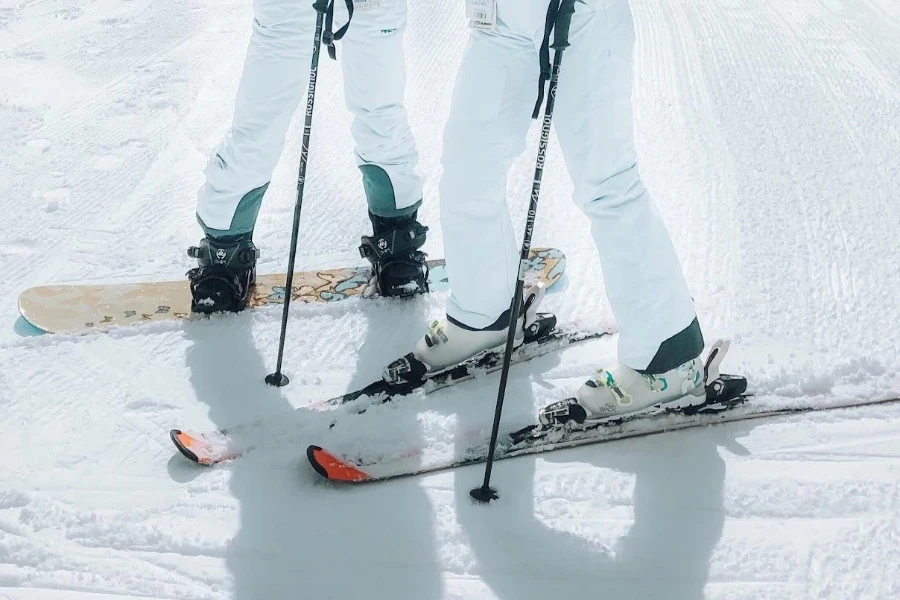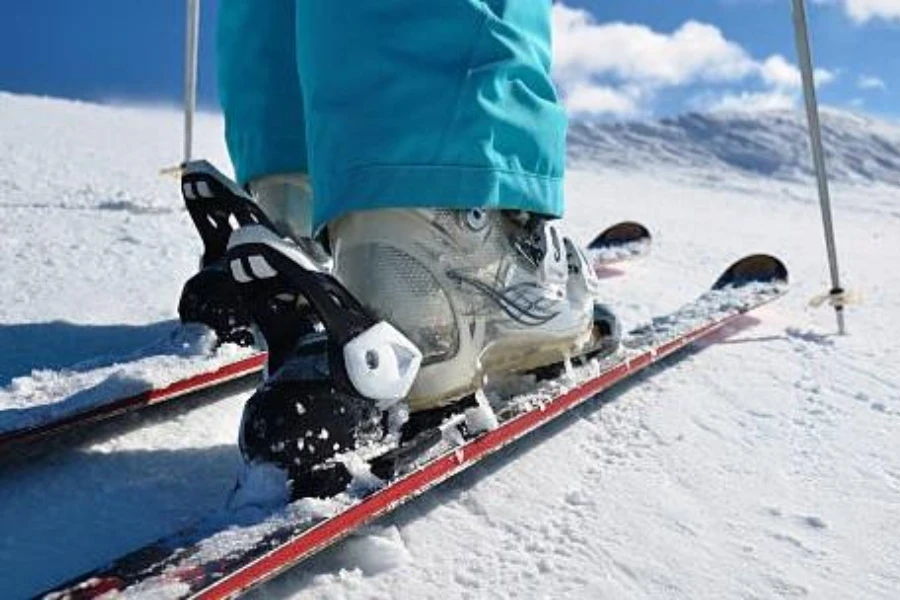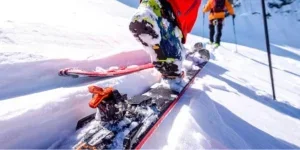Ski bindings make the difference between a fun skiing experience and a potential accident waiting to happen. And with skiing becoming a must-try winter activity, more and more consumers are on the look out for gear that guarantees their safety on the slopes.
Businesses looking to enter the market can therefore leverage this opportunity to increase sales in 2024. However, they must first understand the market and the products they wish to sell prior to jumping in.
Here we’ll outline everything retailers should know about ski bindings before they start selling them in 2024.
Table of Contents
What are ski bindings, and how do they work?
Will the ski binding market remain profitable in 2024?
What are the different types of ski bindings?
What you should consider before stocking up on ski bindings
Conclusion
What are ski bindings, and how do they work?

First created over 50 years ago, ski bindings have been an important part of skiing ever since, helping to connect the skier to their skis yet still allowing for easy movement. More importantly, ski bindings are now optimized with two primary functions in mind: as safety mechanisms or performance optimizers.
As a safety mechanism, ski bindings offer a release function to help skiers move efficiently and disconnecting in the event of a crash without risking injury. Conversely, those that are designed for performance optimization keep the user’s boots and skis firmly in place so as to prevent unnecessary movement and give the skier absolute control.
Will the ski binding market remain profitable in 2024?
Ski tourism and growing participation in winter sports have caused consumer interest in skis and related gear to skyrocket. Consumers nowadays are also more conscious of safe skiing, which explains why bindings continue to be profitable.
According to reports, the global ski binding market predicts a record CAGR of over 6% from 2020 to 2027, reaching a massive value of US $8.4 billion by 2027.
Regionally, North America, Asia, and the Middle East are showing impressive growth prospects in the global market.
What are the different types of ski bindings?
Alpine bindings
The most common type of binding are alpine ski bindings (A.K.A. downhill bindings). True to their name, they’re the best option for downhill skiing, allowing for controlled descents and easy turns. These bindings average 390 searches monthly on Google Ads.
Because alpine bindings are designed specifically for downhill skiing, manufacturers use durable materials to help them withstand significant force. Usually, these materials include metal, reinforcing fibers, and steel.
Alpine bindings also prioritize control and safety. Hence, they often come with adjustable fittings designed to release boots in situations involving accidental force or falls.
Backcountry bindings

Backcountry bindings are the go-to for skiing off piste and on hills. Attracting 720 searches monthly average searches based on Google Ads data, they feature lightweight materials that allow consumers to easily navigate ungroomed mountains – and their built-in risers enhance their versatility.
However, it’s worth noting that these ski bindings offer varying performances depending on the materials used to make them, causing them to perform differently in various conditions.
Nonetheless, backcountry bindings have one guaranteed feature: helping skiers to easily navigate uphill and downhill pistes. Compared to alpine bindings, backcountry bindings have an optional brake mechanism, which provide a similar performance.
Alpine touring bindings
Alpine touring bindings are the most popular type of bindings on the market today, with Google Ads receiving an average of 2,400 monthly searches. Alpine touring bindings are different in that they provide dual uphill and downhill functions.
Plus, they offer an integrated brake system to prevent ski loss during use as well as durable biding materials to lock boots in place.
Businesses can invest in two types of alpine touring bindings: tech or frame. Tech bindings utilize metal pins that connect the binding’s steel frame to the ski boots. Despite this, they’re still lightweight enough to make even the smallest movement feel natural, helping users make quick transitions.
Conversely, frame bindings offer express compatibility, meaning consumers can use them with alpine or standard boots. As well as being DIN certified, they also have adjustable release settings to keep users secure and prevent accidents and falls.
Telemark ski bindings
These bindings are the perfect option for telemark skiing. Their free heel design promotes movement fluidity and easy turns, and while designed specifically for downhill touring, this helps give them enough flexibility for uphill movement too.
Like backcountry bindings, telemark variants offer varying features depending on the preferred variant, for example:
- Some telemark bindings release while others don’t
- Some are lightweight, but others are heavier
- Telemark bindings may have brake adjustments, while others may feature leashes
- Most telemark bindings offer step capabilities, while others require improved balance and control skills
Nonetheless, telemark ski bindings attract 1,900 average monthly searches, according to Google Ads data.
What you should consider before stocking up on ski bindings
Ski binding brake width
All ski bindings come with brakes and, for safety reasons, ensuring that the brake width is compatible with the adjoining ski should be a top priority. Skis with an incompatible brake won’t dig into the snow to stop sliding, potentially leading to accidental falls or injuries.
Generally, the brake width should be 5-10mm wider than the ski’s middle section. If the brake width is larger than the recommended size, it may damage the ski during heavier falls. However, if the width is too small, the brakes won’t function properly.
Construction and durability

Durability is important to consider when purchasing ski bindings because the materials that manufacturers use to craft their ski bindings will impact performance. Preferably, ski bindings should be made from a strong material that can withstand the strong forces generated by skiing.
Below are the different ski binding materials and their durability ratings:
| Ski binding material | Durability rating |
| Steel | Excellent durability (the best material for skin bindings) |
| Aluminum | Very good durability |
| Composite | Good durability |
| Plastic | Fair durability |
Construction is another aspect businesses mustn’t ignore, as it will likely affect the binding’s adjustability, with defective constructions maybe encountering issues related to releasing, causing accidents on the slopes.
Ski binding DIN
DIN is a standard scale used for setting ski bindings, and must not be overlooked by retailers as the wrong setting can cause release failure – a very serious situation that may lead to fatal injuries. Meanwhile, the correct DIN setting helps to ensure an efficient and safe ski performance.
DIN settings depend on the user’s weight and ability level. Below is a table showing DIN settings and the level of skier they relate to:
| DIN setting | Skier weight (kg) | Skier ability level |
| 2 | 22-29 | Beginner |
| 3 | 30-38 | Beginner |
| 4 | 39-47 | Intermediate |
| 5 | 48-56 | Intermediate |
| 6 | 57-66 | Advanced |
| 7 | 67-78 | Advanced |
| 8 | 79-91 | Expert |
| 9 | 92-107 | Expert |
| 10 | 108-125 | Expert |
| 11 | 126-147 | Expert |
| 12 | 148-174 | Expert |
| 13 | 175-209 | Expert |
Ski boot and binding compatibility

Since ski bindings help to secure boots and ensure stable performance, they follow different standards to ensure skier safety. However, these standards mean that ski bindings don’t have universal compatibility, so not all boots will work with each type.
Below is a simple table breaking down the different ski binding standards and their boot compatibility boots:
| Ski binding | Compatible boot | Incompatible boot |
| Alpine bindings | Alpine Boots ISO 5355 certified | – WTR ISO 9523 compliant – Grip walk boots ISO 9523 compliant – Touring boots ISO 9523 compliant |
| Grip walk bindings | – Alpine Boots ISO 5355 certified – WTR ISO 9523 compliant Grip walk boots ISO 9523 compliant | Touring boots ISO 9523 compliant |
| Multinorm certified bindings | – Alpine Boots ISO 5355 certified – WTR ISO 9523 compliant Grip walk boots ISO 9523 compliant – Touring boots ISO 9523 compliant |
Conclusion
Skiing is a fast-paced and intensive sport, meaning that consumers must feel secure when hitting the slopes. Ski bindings – whether alpine, backcountry, alpine touring, and telemark – are integral to maintaining safety, reducing a skier’s risk of injury in the case of a fall.
It’s important then that businesses offer suitable ski bindings and take into consideration of various factors so as to best understand the right varieties for their consumers. These factors include ski brake width, DIN setting, and boot compatibility.
If you’re looking to source the latest in ski bindings, look no further than the thousands of options on Alibaba.com.




